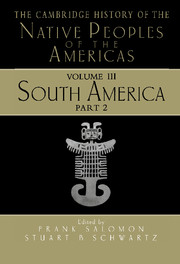Book contents
- Frontmatter
- Contents
- Illustrations
- 14 The Crises and Transformations of Invaded Societies: The La Plata Basin (1535–1650)
- 15 The Colonial Condition in the Quechua-Aymara Heartland (1570–1780)
- 16 Warfare, Reorganization, and Readaptation at the Margins of Spanish Rule: The Southern Margin (1573–1882)
- 17 The Western Margins of Amazonia from the Early Sixteenth to the Early Nineteenth Century
- 18 Warfare, Reorganization, and Readaptation at the Margins of Spanish Rule – The Chaco and Paraguay (1573–1882)
- 19 Destruction, Resistance, and Transformation – Southern, Coastal, and Northern Brazil (1580–1890)
- 20 Native Peoples Confront Colonial Regimes in Northeastern South America (c. 1500–1900)
- 21 New Peoples and New Kinds of People: Adaptation, Readjustment, and Ethnogenesis in South American Indigenous Societies (Colonial Era)
- 22 The “Republic of Indians” in Revolt (c. 1680–1790)
- 23 Andean Highland Peasants and the Trials of Nation Making during the Nineteenth Century
- 24 Indigenous Peoples and the Rise of Independent Nation-States in Lowland South America
- 25 Andean People in the Twentieth Century
- 26 Lowland Peoples of the Twentieth Century
- Index
19 - Destruction, Resistance, and Transformation – Southern, Coastal, and Northern Brazil (1580–1890)
Published online by Cambridge University Press: 28 March 2008
- Frontmatter
- Contents
- Illustrations
- 14 The Crises and Transformations of Invaded Societies: The La Plata Basin (1535–1650)
- 15 The Colonial Condition in the Quechua-Aymara Heartland (1570–1780)
- 16 Warfare, Reorganization, and Readaptation at the Margins of Spanish Rule: The Southern Margin (1573–1882)
- 17 The Western Margins of Amazonia from the Early Sixteenth to the Early Nineteenth Century
- 18 Warfare, Reorganization, and Readaptation at the Margins of Spanish Rule – The Chaco and Paraguay (1573–1882)
- 19 Destruction, Resistance, and Transformation – Southern, Coastal, and Northern Brazil (1580–1890)
- 20 Native Peoples Confront Colonial Regimes in Northeastern South America (c. 1500–1900)
- 21 New Peoples and New Kinds of People: Adaptation, Readjustment, and Ethnogenesis in South American Indigenous Societies (Colonial Era)
- 22 The “Republic of Indians” in Revolt (c. 1680–1790)
- 23 Andean Highland Peasants and the Trials of Nation Making during the Nineteenth Century
- 24 Indigenous Peoples and the Rise of Independent Nation-States in Lowland South America
- 25 Andean People in the Twentieth Century
- 26 Lowland Peoples of the Twentieth Century
- Index
Summary
The indigenous peoples of Brazil responded to the European invasions in a variety of ways that drew on aboriginal social and cultural patterns but also transformed these in response to particular historical circumstances and opportunities. Through a series of case studies, this chapter offers a broad synthesis of the history of indigenous societies in Brazil from the colonial period to the beginning of the republic. Although vast areas have been left out of the discussion, the chapter, by concentrating primarily on the south, the central coast and northeast, and the Amazon Valley, traces the main themes and processes that characterized indigenous contact with Europeans. Within each area attention focuses on the dynamics of pre- and postcontact history of specific peoples and regions: the Guaraní, Kaingang, and Xokleng of the modern-day states of São Paulo, Paraná, Santa Catarina, and Río Grande do Sul; the Payaguá and Guaykurú (also written as Guaycurú) of the Paraguay River drainage; the Kariri of the northeastern interior and Botocudo of the states of Espirito Santo, Minas Gerais, and Bahia; and for the Amazon Valley, the peoples of the várzea from die mid-to-upper Amazon and several of its main tributaries (the Tapajós, Madeira, and Negro; see Map 19.1). These cases are illustrative of processes that characterize much of lowland South America. Together they demonstrate that by the beginning of the twentieth century, the dynamics of change in indigenous societies were based on an entirely different set of factors than those that had been their principal determinants in the colonial and imperial periods.
THEMATIC OVERVIEW
The cases selected for presentation illustrate one or more of the following themes, which have guided the construction of this chapter: (1) diversity of aboriginal sociocultural patterns; (2) patterns of penetration and conquest; (3) directions in Indian policy; (4) transformations in interethnic relations; and (5) forms of adaptation and strategies of resistance.
Diversity of Aboriginal Sociocultural Patterns
In all areas of Brazil, early explorers were astonished at the density and diversity of native populations. Such diversity represented complex and varied forms of spatial organization and settlement patterns reflecting different cultural orientations and adaptations to specific ecological circumstances. Thus the south had an altogether distinct human landscape in terms of spatial organization and group mobility from the Amazon floodplains and the eastern and northeastern interior.
- Type
- Chapter
- Information
- The Cambridge History of the Native Peoples of the Americas , pp. 287 - 381Publisher: Cambridge University PressPrint publication year: 1999
- 2
- Cited by

